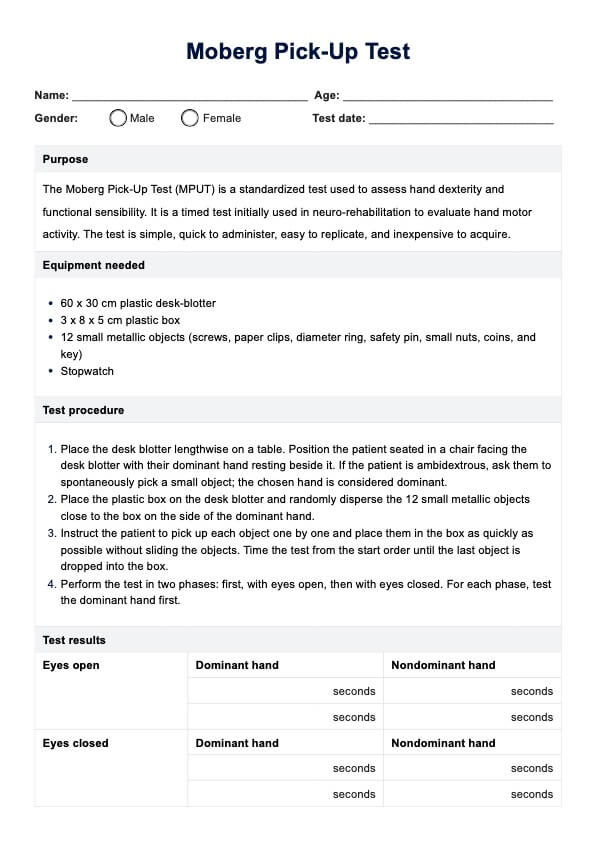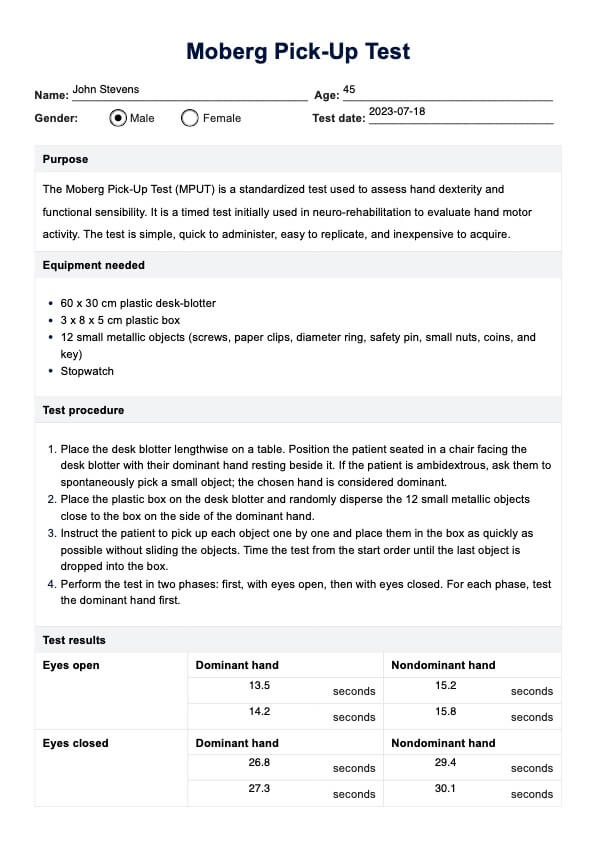Moberg Pick-Up Test
Learn how to use the Moberg Pick-Up Test template to assess hand dexterity and functional sensibility effectively. Enhance your assessments with our detailed guide!


What is the Moberg Pick-Up Test?
The Moberg Pick-Up Test (MPUT) is a standardized assessment to evaluate hand dexterity and functional sensibility. Initially developed for neuro-rehabilitation, the test measures hand motor activity and is quick and easy to administer. It is done by measuring the time precision grip for picking up small objects, like screws, paper clips, diameter rings, small nuts, coins, keys, and safety pins, and placing them in a box (Amirjani et al., 2007; Santos-Eggimann et al., 2020).
The Moberg Pick-Up Test is beneficial for patients with hand pathologies such as carpal tunnel syndrome, hand inflammatory disease, rheumatoid arthritis, osteoarthritis, and peripheral nerve injuries. It helps assess the functional performance of the upper limbs, making it an essential tool in diagnosing and managing these conditions (Physiopedia, n.d.). Additionally, it is widely used because it is inexpensive, simple to replicate, and provides valuable insights into a patient’s hand functionality. The test has good to excellent test-retest and inter-rater reliability, with a coefficient alpha for test-retest reliability of 0.985.
Moberg Pick-Up Test Template
Moberg Pick-Up Test Example
How to use our Moberg Pick-Up Test template
Our Moberg Pick-Up Test template is designed to streamline the assessment process, ensuring accurate and consistent results. Follow these steps to use the template effectively:
Step 1: Download the template
Start by downloading the Moberg Pick-Up Test template from our resources. Ensure you have all the necessary equipment ready.
Step 2: Prepare the patient
Position the patient seated in a chair facing a table with the desk blotter placed lengthwise. Ensure their dominant hand is resting beside the desk blotter. For ambidextrous patients, ask them to pick a small object spontaneously to determine the dominant hand.
Step 3: Set up the test area
Place the plastic box on the desk blotter and randomly disperse the 12 small metallic objects, including a safety pin, close to the box on the dominant hand's side.
Step 4: Conduct the test
Instruct the patient to pick up each object one by one and place them in the box as quickly as possible without sliding the objects. Time the test from the start order until the last object is dropped into the box. Perform the test in two phases: first, with eyes open, then with eyes closed. For each phase, test the dominant hand first.
Step 5: Record the results
Document the times taken for both the dominant and nondominant hands, for both the eyes open and eyes closed phases. Use this data for further analysis and comparison against normative values.
Scoring and interpretation of the Moberg Pick-Up Test
The Moberg Pick-Up Test results are scored based on the time the patient takes to pick up and place all objects in the box. This time is recorded for both the dominant and nondominant hands, and the test is performed twice: once with the patient’s eyes open and once with their eyes closed. The test evaluates the functional performance of upper limbs in patients with hand pathologies such as carpal tunnel syndrome, osteoarthritis, and rheumatology. The normative data provided in the template helps interpret these results, allowing healthcare professionals to compare the patient’s performance against standard values for different age groups and genders.
Interpreting the test results involves comparing the patient’s times to the normative data. Time spans significantly longer than the normative values may indicate hand dexterity or functional sensibility issues, often seen in conditions like carpal tunnel syndrome, rheumatoid arthritis, and other hand pathologies. Conversely, times within or close to the normative range suggest normal hand function. This information can guide further diagnostic and therapeutic interventions to improve the patient’s hand function and overall quality of life (Amirjani et al., 2007; Santos-Eggimann et al., 2020).
Using the MPUT template ensures that the test is conducted and scored consistently, providing reliable data for patient assessment. The detailed documentation of patient performance aids in tracking progress over time and evaluating interventions’ effectiveness, making it a valuable tool in clinical practice.
Benefits of using our template
Using our Moberg Pick-Up Test template simplifies the assessment process for healthcare professionals and ensures accurate and consistent results. Here are three key benefits:
Standardization of the standardized test
Our template provides a standardized method for conducting the Moberg Pick-Up Test, a test to assess hand dexterity and functional sensibility. This ensures that all necessary steps are followed consistently, helping to minimize errors and variability in test results. It also makes comparing and tracking patient progress easier.
Efficiency
Using a pre-designed template saves healthcare professionals time when setting up and administering the test. The template includes all essential fields and guidelines, streamlining the process and allowing for more efficient testing sessions. This efficiency enables more patients to be assessed in less time.
Comprehensive documentation
The template ensures comprehensive documentation of patient data, test conditions, and results. This thorough record-keeping facilitates better analysis and follow-up, allowing for more effective monitoring of patient outcomes. Accurate documentation also aids in developing tailored treatment plans based on the test findings.
References
Amirjani, N., Ashworth, N. L., Gordon, T., Edwards, D. C., & Chan, K. M. (2007). Normative values and the effects of age, gender, and handedness on the Moberg pick-up test. Muscle & Nerve, 35(6), 788–792. https://doi.org/10.1002/mus.20750
Santos-Eggimann, B., Ballan, K., Fustinoni, S., & Büla, C. (2020). Measuring slowness in old age: Times to perform Moberg picking-up and walking speed tests. Journal of the American Medical Directors Association, 21(11), 1729-1734.e2. https://doi.org/10.1016/j.jamda.2020.03.020
Physiopedia. (n.d.). Moberg pick-up test. https://www.physio-pedia.com/Moberg_Pick-Up_Test
Commonly asked questions
The Moberg Pick-Up Test assesses hand dexterity and functional sensibility, particularly in patients with conditions such as carpal tunnel syndrome, rheumatoid arthritis, and peripheral nerve injuries.
The test involves quickly picking up small metallic objects and placing them in a box. It is conducted in two phases: with eyes open and eyes closed, testing both the dominant and nondominant hands.
The test requires a plastic desk blotter, a plastic box, 12 small metallic objects (e.g., screws, paper clips, coins), and a stopwatch.
The results are interpreted by comparing the time taken to complete the test with normative data based on age and gender. Longer times may indicate issues with hand dexterity or functional sensibility.
Yes, the Moberg Pick-Up Test can evaluate functional performance in patients with upper limb pathology. It is effective in assessing conditions such as rheumatology, carpal tunnel syndrome, osteoarthritis, and the absence of upper limb pathology.







































































































